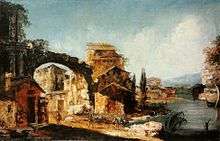Michele Marieschi


Michele Marieschi (1 December 1710 – 18 January 1744), also known as Michiel, was an Italian painter of landscapes and cityscapes (i.e., a vedutista) who painted his vedute, or views, mostly in Venice.
Biography
Less well-known than his famous contemporary vedutisti Canaletto and Francesco Guardi, Marieschi was born in Venice in 1710, the son of a woodcarver.[1] According to his biography in P.A. Orlandi's Abecedario Pittorico, published in Venice in 1753,[2] he spent some time in Germany, where he may have worked as a scene-painter. [1] He returned to Venice in about 1735.[3] Between 1735 and 1741 he was registered in the Venetian Fraglia de' Pittori, or painters' guild. One of Marieschi's sponsors at his wedding in 1737 was Gaspare Diziani.[1] Although he initially produced capricci (i.e. fanciful scenes), he later painted more topographically accurate vedute. One of his patrons was the noted collector Johann Matthias von der Schulenburg, who bought at least two canvases from him for 50 and 55 gold sequins respectively.
Michael Levey contrasts Marieschi's style with Canaletto's, noting that Marieschi's use of paint is livelier and fresher.[3]
In 1741 Marieschi published a set of 21 etchings of Venice, under the title of Magnificentiores Selectioresque Urbis Venetiarum Prospectus; the title page featured a portrait of Marieschi by Angelo Trevisani.[1]
References
- 1 2 3 4 Links 1977, p. 55.
- ↑ Links 1977, p. 106.
- 1 2 Levey 1980, p. 125.
| Wikimedia Commons has media related to Michele Marieschi. |
Sources
- Levey, Michael (1980). Painting in Eighteenth-Century Venice= (Second ed.). Oxford: Phaidon.
- Links, J. G. (1977). Canaletto and his Patrons. London: Paul Elek. pp. 55–56.
- Mauroner, Fabio (April 1940). "Michiel Marieschi with Catalogue of the Etchings". The Print Collector’s Quarterly. 27 (2): 179.
- Wittkower, Rudolf (1993). Art and Architecture Italy, 1600-1750. Penguin Books. p. 501.
External links
- Biography
- www.artistarchive.com A catalogue of the 21 plates from Magnificentiores Selectioresque Urbis Venetiarum Prospectus.
- Canaletto, a full text exhibition catalog from The Metropolitan Museum of Art, which contains material on Marieschi